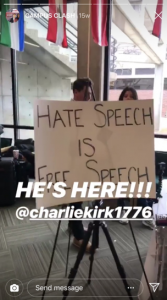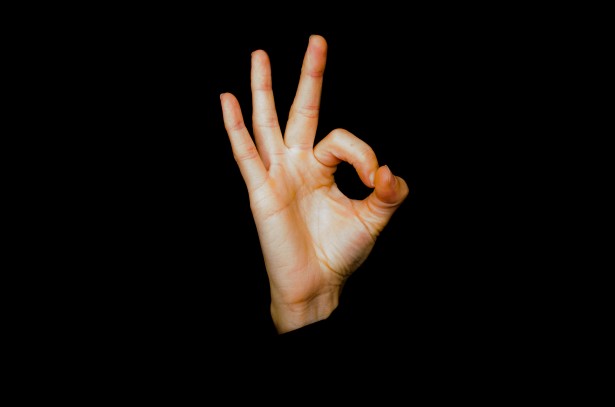Scott: Closing the Distance Between a Real and Fake Hate Symbol
October 18, 2019
Last month, the Anti-Defamation League registered the “OK” sign into its database of hate symbols. As the press release spread across social media, people bemoaned the state of the world, tainted by the supposed fragility of self-victimizing social justice warriors. In their words, the ADL was bored, looking for trouble and possibly a hate group themselves. They asked what would become of the innocent “OK” signs — did liberals really want to label every scuba diver, sports coach or person using ASL as a racist?
The short answer is no. The ADL’s recognition of the “OK” sign as a potential hate symbol was not done to retroactively tie the innocent to hate groups — that was the intent of the alt-right activists who began this controversy in the first place. In 2017, the online alt-right cooked up “Operation O-KKK,” a 4chan hoax to associate the “OK” sign with white power. They gleefully flashed the sign in photos, stirring liberals and journalists into a panic that secret “OK” signs were the latest evidence of a deep, racist conspiracy. “To any who haven’t seen the original thread, our goal is to convince people on twitter that the ‘ok’ hand sign has been co-opted by neo-Nazis,” the original 4chan thread wrote.

As tweeted by the ADL’s Mark Pitcavage last year, the “OK” sign is not the ultimate arbiter of white supremacist beliefs. Context is key. A group of kids playing the “circle game” is obviously different from a group of activists adopting it for political purposes. As far as alt-right trolls go, I have difficulty seeing how smirking “ironic” expressions of hate are fundamentally different from “real” ones. If you know a symbol could be misconstrued as meaning “white power” and then intentionally make it within a context so that it will be misconstrued as such, how are you not effectively making a white power sign?
Still, some may say that none of this matters, that symbols only carry the power we give them. That sounds simple enough, but try explaining that it “just doesn’t matter” to the 6-year-old girl who had the sign made on her shoulder by a costumed character at the Universal Orlando Resort. Tiffiney Zinger, the girl’s mother, is black and rightfully hurt that that she had to try to explain racism to her biracial daughter after what was supposed to be a special family vacation. “It’s hard to tell a child at age 7 that there’s already adults that are targeting her,” Zinger said.

This is not the only troubling appearance of the “OK” sign within the last year. The New Zealand gunman, who killed 50 people inside two Christchurch mosques, had flashed the symbol during his trial. A Chicago Cubs fan made an “OK” behind the back of a black sports reporter. Four Alabama police officers were suspended for making the sign in a posed photo, though they claimed it was only a game. A member of a U.S. Coast Guard team was reassigned after making the symbol during a TV broadcast — sitting at a desk in the background, he appeared to notice the camera and slowly raised his curled fingers up to his head.
The sign has also been made by Richard Spencer, Milo Yiannopoulos, Mike Cernovich and Charlie Kirk, the dapper young edge-lords of today’s alt-right. Bigoted behavior that was once too toxic for the mainstream has been spiffed up and reintroduced by each of these activists, and it is clear that they have spread their tactics to their young fan base.
Last March, Turning Point USA founder Kirk and his colleague Candace Owens were invited to host a Campus Clash event at Utah Valley University. As well as advertising Kirk and Owens’s performance, the @turningpointbyu Instagram account shared photos of an attendee of the event flashing the OK sign. In another photo, the club displayed a poster reading “Hate speech is free speech.” That may be true, but it seems to indicate an admission that much of what Kirk and Owens spew is hate.

It is truly unfortunate that the “OK” sign has been weaponized like this by alt-right groups. Like junior high school students scribbling swastikas into desks, some people are amused by the shock value, never thinking or caring how it will affect others. This facetious move by this student organization has sent a message about who they are and are not for. No level of irony makes “white power” funny — especially not to Utah students who have been the target of racist bullying.
White supremacy is not a joke, nor are its effects absent from Utah. Between 2017 and 2019, 29 separate displays of white supremacist propaganda occurred in Utah, including racist fliers and stickers plastered across the University of Utah campus and a large banner that was draped over the block U. Last April, The Daily Utah Chronicle reported on a former U employee who was tied to the propaganda on campus. Hate crimes occur in Utah, and student groups and the future leaders within them should be sensitive, not snarky.
Unfortunately, the linkage of the once (and often still) innocent “OK” sign to white supremacy has put the symbol in a fraught position. People who use it without malice may now second guess themselves lest they accidentally contribute to the ugliness. It is understandable that some people — especially those who do not keep close tabs on rising white supremacist activity — feel jarred by the new meaning. But the reaction should not be to lash out and join in on the mockery. It is better to begin to use a symbol with caution than to willfully ignore such deceptive whispers of hate.








